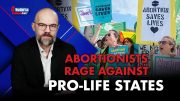
Americans might soon be advised to wear N95 and KN95 respirators in order to curb the spread of the Omicron variant.
The U.S. Centers for Disease Control and Prevention (CDC) is planning to update its guidelines for mask-wearing, and will advise that, if people can “tolerate wearing a KN95 or N95 mask all day,” they should do so, The Washington Post reports.
The report reads,
With the highly transmissible omicron variant spurring record levels of infections and hospitalizations, experts have repeatedly urged the Biden administration to recommend the better-quality masks rather than cloth coverings to protect against an airborne virus, and to underscore the importance of masking. “The agency is currently actively looking to update its recommendations for KN95 and N95 in light of omicron,” the official said. “We know these masks provide better filtration.”
KN95 and N95
According to the CDC, both KN95 and N95 are, technically speaking, respirators, and not masks.
Dr. Kavita Patel, managing director of clinical transformation at the Brookings Institution’s Engelberg Center for Health Care Reform, explains that both N95 and KN95 respirators are made from multiple layers of synthetic material (typically a polypropylene plastic polymer) and are designed to be worn over the mouth and nose. Both respirators are designed to filter out and capture 95 percent of 0.3-micron particles in the air (hence the “95” in the names). That size, however, is still much larger than the size of SARS-CoV-2, which is estimated to range from 50 to 140 nanometers. Since there are 1,000 nanometers in one micron, trying to stop the spread of the virus with this type of face covering appears problematic.
The main difference between the N95 and KN95 masks comes mainly from slightly varying standards set out by American and Chinese regulators. KN95 are approved by China, and N95 are approved by the FDA but are usually manufactured in China.
Use for General Public
According to the Food and Drug Administration (FDA), most N95 respirators are specifically designed for use in construction and other industrial jobs that expose workers to dust and small particles, and for use in healthcare settings. They are regulated by the National Personal Protective Technology Laboratory (NPPTL) in the CDC’s National Institute for Occupational Safety and Health (NIOSH).
The FDA explicitly says people need to follow precautions when using them. For example, because “N95 respirator can make it more difficult for the wearer to breathe,” those with “chronic respiratory, cardiac, or other medical conditions that make breathing difficult” should consult with their healthcare provider before using them.
In addition to that, the regulators say that N95 is not designed for children or people with facial hair since “a proper fit cannot be achieved” in those groups.
In September, the FDA alerted healthcare workers about certain Chinese-made N95 respirators that were no longer considered safe due to “serious” quality concerns. Those N95s’ approval has been revoked.
The respirators are intended for a single use only, so daily wearing can become quite expensive. According to Bloomberg, news of the CDC’s update on masking recommendation hiked N95 prices: A pack of 40 KN95 masks of the Hotodeal brand on Amazon.com jumped from $16.99 in late November to $79.99, per the outlet.
Before rushing to stock up on N95 respirators, one should also keep in mind that 60 percent of all KN95 respirators in the United States are counterfeit (fake), per the CDC.
Current guidelines
The current version of the CDC guidelines, last updated in October, recommends everyone older than two years of age wear a snugly-fit cloth mask with at least two layers of “washable, breathable fabric.”
The agency specifically advises the general population against choosing N95 respirators marked “surgical” since they are prioritized for healthcare personnel. However, per The Washington Times, that recommendation, issued back when personal protection equipment (PPE) was in short supply, is no longer relevant, since “there are no longer serious shortages of N95 masks.”
Masks for All?
On Wednesday, Senator Bernie Sanders (I-Vt.), along with more than 50 of his Democrat colleagues in the Senate and House, reintroduced the bill dubbed “Masks for All Act” that would make the federal government send every American a package of three N95 masks.
Stating that “not all masks are created equal,” Sanders said that “Congress must demand the mass production and distribution of N95 masks, one of the most effective ways to stop the spread of the Covid virus.”
Sanders’ announcement makes a grim read that may be summarized as: “All Americans will likely die if they don’t wear N95. Also, get vaccinated and tested.”
It is unclear what difference in COVID transmission rate Sanders expects to see with every American using a respirator three times.
President Joe Biden said on Thursday that an announcement about sending high-quality masks to Americans for free is coming next week.
“I know we all wish that we could finally be done with wearing masks. I get it. But there is a really important tool to stop the spread, especially the highly transmissible omicron variant. So please, please wear the mask,” Biden urged.
On Wednesday, CDC director Rochelle Walensky said during a White House briefing that her agency had no plans to change its guidelines, and will continue to recommend that “any mask is better than no mask.”
Multiple studies (here and here) suggest that mask use makes little to no difference in COVID transmission.
The Mises Institute, which tracked the trends between mask usage and death/hospitalization rates based on the official CDC data, found that the 10 states with the highest rate of mask usage have been doing worse in both cases and death rates than the 10 states with the lowest rate of mask usage.
“If we are assuming fairly consistent rates of mask usage across the entire duration of the pandemic while also assuming that the science behind masks is truly settled, it’s quite difficult to explain away any period of time in which states with the lowest rates of mask usage were outperforming states with the highest rates,” the researchers observed.
Given that by the CDC’s own admission, asymptomatic transmission “appears to be present in lower concentrations and for a shorter period than in symptomatic persons” and given the studies (here and here) suggesting that asymptomatic transmission is either negligible or non-existent, healthy or asymptomatic people likely don’t need to wear respirators on their faces to prevent transmission or infection.





